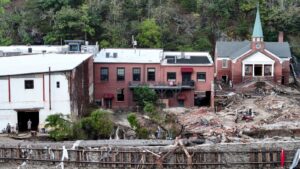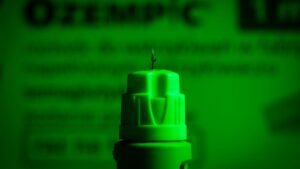Magnetic resonance imaging, or MRI scanning, is a diagnostic technique now familiar to almost everyone who has had a bad back, a damaged knee or a suspected stroke.
During the 1970s and 80s the Oxford biochemist Sir George Radda, who has died aged 88, worked with the same underlying physics to generate not an image but a spectrum that showed the biochemical state of the muscles and organs revealed. For the first time, it was possible to diagnose metabolic diseases without invasive tissue sampling.
Radda, an ambitious and hard-working scientist, went on to head the UK’s Medical Research Council (MRC) in 1996. Some of the projects he helped drive through in this role were British Biobanka database of 500,000 volunteers who contributed genetic information, medical histories and questionnaires on topics such as diet and mental health. Biobank has proven a valuable source of data for researchers investigating the links between genetics, lifestyle and disease.
MRI and magnetic resonance spectroscopy (MRS) take advantage of the fact that the nuclei of atoms in materials, including living tissue, are magnetic and align when placed in a magnetic field. A burst of radio waves will momentarily knock them out of alignment, and when they return to rest, the atoms emit a spectrum of characteristic signals.
In the early 70s, Radda collaborated with a group in the University of Oxford’s biochemistry department. Rex Richardsa chemistry professor, to study enzymes in solution. Richards raised money to commission Oxford Instruments (OI) to develop a superconducting magnet for MRS studies of solutions in test tubes.
In 1974, young researchers from the joint MRS group made the astonishing discovery that you can get a spectrum from a whole rat muscle, not just from a suspension of dissociated cells. This raised the question of whether you might be able to get a spectrum from a living animal, or part of a human body.
Radda obtained the substantial funds needed for OI to design and build a spectrometer large and powerful enough to take either a whole, anesthetized laboratory animal or a human arm or leg.
Successful testing by the MRS team led to the machine being moved to the nearby Radcliffe Infirmary, where Radda set up a clinical research facility. In 1981, the team published its successful diagnosis of the rare metabolic disorder McArdle disease in a human patient. By the late 80s, Radda had established a new clinical facility at Oxford’s John Radcliffe Hospital, with a spectrometer large enough to take a human body, to examine conditions of the brain and heart. Medical MRS is still used today, although MRI has wider clinical applications.
Born György Radda in Győr, Hungary, he was the son of Anna Bernolak and Gyula Radda, both doctors. He was educated at the Benedictine monastery of Pannonhalma before entering Eötvös Loránd University in Budapest to study chemistry.
After the Soviet invasion of Hungary in 1956 he decided to leave the country and seek his fortune elsewhere. His parents agreed, as long as he took his younger brother and older sister with him. They bribed border guards and walked into Austria, along with many of the 200,000 other Hungarian refugees who left the country at the same time.
In Vienna, the destitute Radda was interviewed by Oxford professors who were recruiting refugee students for British universities. They brought him on a flight to the UK with 30 others, only four of whom, including Radda, were eventually selected to study at Oxford University.
He was admitted to Merton College after a two-month crash course in English and went on to gain a first-class degree and DPhil in chemistry. Through college connections, he obtained naturalized British citizenship, which enabled him to accept a Fulbright scholarship to work at the University of California, Berkeley, with biochemist Melvin Calvin, who had just won a Nobel Prize.
He returned to a research fellowship in Oxford’s biochemistry department, where he conducted his research on enzymes and clinically oriented MRS. In 1984 he was named British Heart Foundation Professor of Molecular Cardiology, and in 1991 he became head of the biochemistry department.
In his years as head of the MRC, from 1996 to 2003, Radda spearheaded what the journal Nature described as “the biggest shake-up of its funding … for university research for three decades”. The changes essentially prioritized large, long-term, multidisciplinary collaborative projects like Biobank over “curiosity-driven,” smaller projects that relied on the ingenuity of individual group leaders.
He also introduced a new system to determine whether such smaller projects will be funded or not; but with less money available, even those rated best could not be sure of receiving funds.
He also sought to close the long-established and highly regarded National Institute of Medical Research (NIMR) at Mill Hill, London, and bring it under the wing of a top university such as Cambridge. These changes caused a stir, especially in universities outside the “golden triangle” of Oxford, Cambridge and London, where scientists feared they were being frozen out.
Things came to a head in 2003, when the House of Commons science and technology committee issued a highly critical report into the way the MRC allocated its funding. Radda’s tenure ended later that year and his successor, Colin Blakemorehad an uphill task in repairing relations.
However, Biobank is now considered a huge success, and NIMR eventually closed in 2015 and merged with other institutions to form the multidisciplinary Francis Crick Institute in Camden, a partnership between six biomedical research organizations including the MRC and University College London.
Radda has received many honours, including a CBE in the 1993 Birthday Honors and a knighthood in 2000 for his services to biomedical science. Shortly after leaving the MRC, he was invited by Philip Yeo, the executive chairman of the Agency for Science, Technology and Research (A-STAR) in Singaporeto advise on the development of research there.
At the same time, he accepted Oxford University’s offer to take on the task of merging two research departments, physiology and anatomy, and to become founding head of the new department of physiology, anatomy and genetics, a position he held from 2006 to 2008 .
From 2009, he chaired Singapore’s Biomedical Research Council and oversaw a group of research institutes. For more than a decade, he commuted to Singapore every month, became an honorary citizen in 2015 and finally retired in 2016 when he was 80 years old.
In his spare time, Radda found time to attend opera productions and build up his collection of jazz recordings. He spoke five languages and was widely read and well informed about art. However, science was his passion. He was disappointed to find that, with ill health affecting him, he no longer had the drive or ideas to start another project in his 80s.
In the last year of his life, he recorded an interview for the International Society for Magnetic Resonance in Medicine (which he helped to found). Unfortunately, he told retired OI scientist Roy Gordon, “You can’t do good science part-time… You have to say, that’s enough.”
Radda met Mary O’Brien, a fellow student, while doing his DPhil at Oxford. They married in 1961 and had three children, Ann, Mark and Jonathan, but later divorced. In 1995 he married Sue Bailey, who worked in the biochemistry department at Oxford. She survives him, as do his children.






